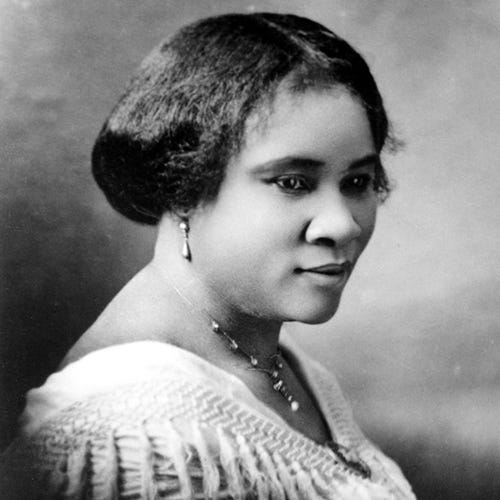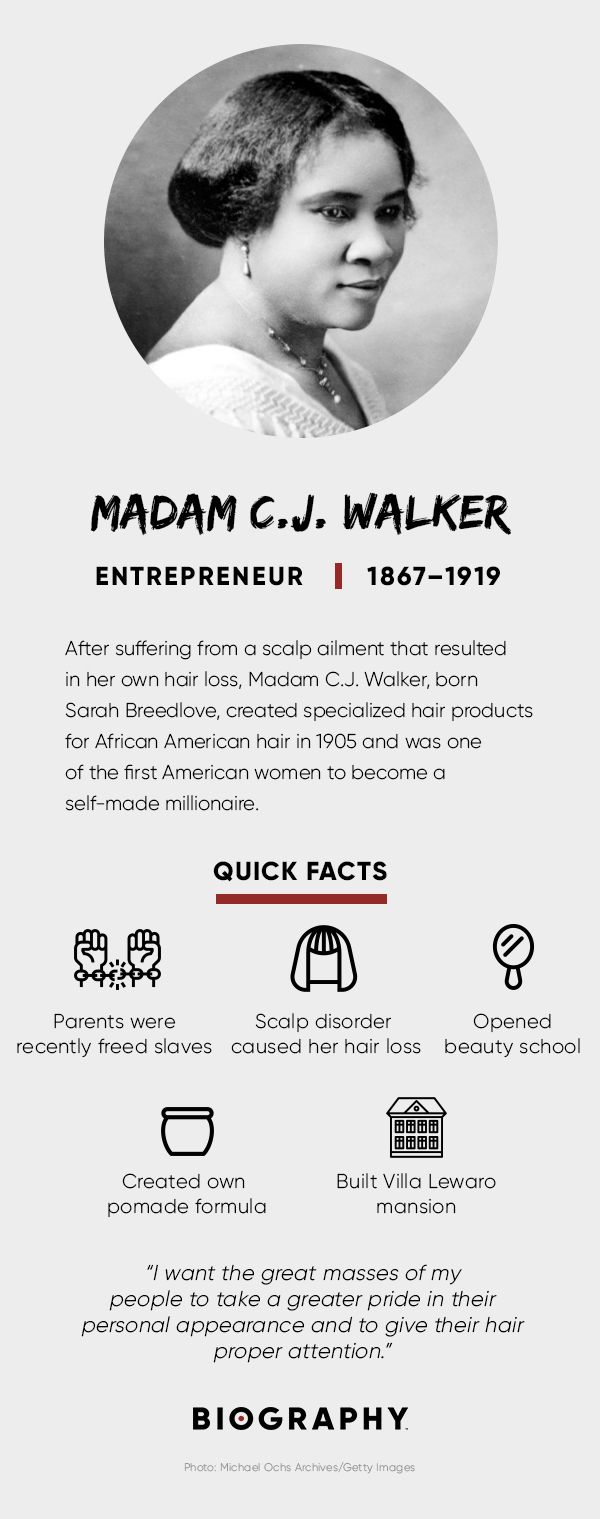You are viewing the article Madam C.J. Walker at Lassho.edu.vn you can quickly access the necessary information in the table of contents of the article below.

(1867-1919)
Who Was Madam C.J. Walker?
Madam C.J. Walker invented a line of African American hair products after suffering from a scalp ailment that resulted in her own hair loss. She promoted her products by traveling around the country giving lecture-demonstrations and eventually established Madame C.J. Walker Laboratories to manufacture cosmetics and train sales beauticians.
Her business acumen led her to be one of the first American women to become a self-made millionaire. She was also known for her philanthropic endeavors, including a donation toward the construction of an Indianapolis YMCA in 1913. Walker’s life was portrayed in the 2020 TV show Self Made, with Octavia Spencer portraying Walker.
Early Life
Walker was born Sarah Breedlove on December 23, 1867, on a cotton plantation near Delta, Louisiana. Her parents, Owen and Minerva, were enslaved and recently freed, and Sarah, who was their fifth child, was the first in her family to be free-born.
Minerva died in 1874 and Owen passed away the following year, both due to unknown causes, leaving Sarah an orphan at the age of seven. After her parents’ passing, Sarah was sent to live with her sister, Louvinia, and her brother-in-law.
The three moved to Vicksburg, Mississippi, in 1877, where Sarah picked cotton and was likely employed doing household work, although no documentation exists verifying her employment at the time.
Daughter A’Lelia Walker
At age 14, to escape both her oppressive working environment and the frequent mistreatment she endured at the hands of her brother-in-law, Sarah married a man named Moses McWilliams. On June 6, 1885, Sarah gave birth to a daughter, A’Lelia.
When Moses died two years later, Sarah and A’Lelia moved to St. Louis, where Sarah’s brothers had established themselves as barbers. There, Sarah found work as a washerwoman, earning $1.50 a day — enough to send her daughter to the city’s public schools.
She also attended public night school whenever she could. While in St. Louis, Breedlove met husband Charles J. Walker, who worked in advertising and would later help promote her hair care business.
Hair Care
During the 1890s, Sarah developed a scalp disorder that caused her to lose much of her hair, and she began to experiment with both home remedies and store-bought hair care treatments in an attempt to improve her condition.
In 1905, she was hired as a commission agent by Annie Turnbo Malone — a successful, Black, hair-care product entrepreneur — and she moved to Denver, Colorado.
READ MORE: How Madam C.J. Walker Invented Her Hair Care Products
Madam C.J. Walker Company
While there, Sarah’s husband, Charles, helped her create advertisements for a hair care treatment for African Americans that she was perfecting. Her husband also encouraged her to use the more recognizable name “Madam C.J. Walker,” by which she was thereafter known.
In 1907 Walker and her husband traveled around the South and Southeast promoting her products and giving lecture demonstrations of her “Walker Method” — involving her own formula for pomade, brushing and the use of heated combs.
Walker Agents
As profits continued to grow, in 1908 Walker opened a factory and a beauty school in Pittsburgh, and by 1910, when Walker transferred her business operations to Indianapolis, the Madam C.J. Walker Manufacturing Company had become wildly successful, with profits that were the modern-day equivalent of several million dollars.
In Indianapolis, the company not only manufactured cosmetics but also trained sales beauticians. These “Walker Agents” became well known throughout the Black communities of the United States. In turn, they promoted Walker’s philosophy of “cleanliness and loveliness” as a means of advancing the status of African Americans.
A relentless innovator, Walker organized clubs and conventions for her representatives, which recognized not only successful sales, but also philanthropic and educational efforts among African Americans.
DOWNLOAD BIOGRAPHY’S MADAME C.J. WALKER FACT CARD
Harlem Years
In 1913, Walker and Charles divorced, and she traveled throughout Latin America and the Caribbean promoting her business and recruiting others to teach her hair care methods. While her mother traveled, A’Lelia helped facilitate the purchase of property in Harlem, New York, recognizing that the area would be an important base for future business operations.
In 1916, upon returning from her travels, Walker moved to her new townhouse in Harlem. From there, she would continue to operate her business, while leaving the day-to-day operations of her factory in Indianapolis to its forelady.
Walker quickly immersed herself in the social and political culture of the Harlem Renaissance. She founded philanthropies that included educational scholarships and donations to homes for the elderly, the NAACP, and the National Conference on Lynching, among other organizations focused on improving the lives of African Americans.
She also donated the largest amount of money by an African American toward the construction of an Indianapolis YMCA in 1913.
House
In 1918, at Irvington-on-Hudson — about 20 miles north of New York City in the Hudson Valley — Walker built an Italianate mansion she called Villa Lewaro. It was designed by Vertner Tandy, an accomplished African American architect.
Villa Lewaro was a gathering place for many luminaries of the Harlem Renaissance, and was designated a National Historic Landmark in 1976.
READ MORE: Madam C.J. Walker and 9 Black Inventors Who Changed Your Life
Death
Walker died of hypertension on May 25, 1919, at age 51, at Villa Lewaro.
In 1981, the Madam C. J. Walker Manufacturing Company ceased operations. A line of cosmetics and hair-care products bearing the name Madam C.J. Walker Beauty Culture is available at Sephora retailers.
Walker left one-third of her estate to her daughter, who would also become well-known as an important part of the Harlem Renaissance, and the remainder to various charities. Walker’s funeral took place at Villa Lewaro, and she was buried at Woodlawn Cemetery in the Bronx, New York.
Legacy and TV Show
In 1927, the Walker Building, an arts center that Walker had begun work on before her death, was opened in Indianapolis. An important African American cultural center for decades, it is now a registered National Historic Landmark. In 1998, the United States Postal Service issued a stamp of Walker as part of its “Black Heritage” series.
Walker’s life was portrayed in the 2020 TV show Self Made, with Octavia Spencer portraying Walker.
QUICK FACTS
- Name: Madam C.J. Walker
- Birth Year: 1867
- Birth date: December 23, 1867
- Birth State: Louisiana
- Birth City: Near Delta
- Birth Country: United States
- Gender: Female
- Best Known For: Madam C.J. Walker created specialized hair products for African American hair care and was one of the first American women to become a self-made millionaire.
- Industries
- Civil Rights
- Business and Industry
- Astrological Sign: Capricorn
- Nacionalities
- American
- Interesting Facts
- Madam C.J. Walker was the first American woman to become a self-made millionaire.
- In 1913, Madam C.J. Walker donated the largest amount of money by an African American toward the construction of an Indianapolis YMCA.
- Also a civil rights activist, in 1917, Madam C.J. Walker was part of a delegation that traveled to the White House to petition President Woodrow Wilson to make lynching a federal crime.
- Death Year: 1919
- Death date: May 25, 1919
- Death State: New York
- Death City: Irvington-on-Hudson
- Death Country: United States
Fact Check
We strive for accuracy and fairness.If you see something that doesn’t look right,contact us!
CITATION INFORMATION
- Article Title: Madam C.J. Walker Biography
- Author: Biography.com Editors
- Website Name: The Biography.com website
- Url: https://www.biography.com/business-leaders/madam-cj-walker
- Access Date:
- Publisher: A&E Television Networks
- Last Updated: November 12, 2021
- Original Published Date: April 3, 2014
QUOTES
- I want the great masses of my people to take a greater pride in their personal appearance and to give their hair proper attention.
- There would be no hair growing business today had I not started it.
- You might say that I was the first and caused others to awaken to the sense of their duty in helping deserving causes for the benefit of the race.
- I am a woman who came from the cotton fields of the South. From there I was promoted to the washtub. From there I was promoted to the cook kitchen. And from there I promoted myself into the business of manufacturing hair goods and preparations.
- This is the greatest country under the sun. But we must not let our love of country, our patriotic loyalty cause us to abate one whit in our protest against wrong and injustice.
- One night I had a dream, and in that dream a big black man appeared to me and told me what to mix up for my hair. I made up my mind I would begin to sell it.
- Perseverance is my motto!
- I am not satisfied in making money for myself. I endeavor to provide employment for hundreds of the women of my race.
- [Perseverance] gave us the telegraph, telephone and wireless. It gave to the world an Abraham Lincoln, and to a race freedom.
- I am not ashamed of my humble beginning. Don’t think because you have to go down in the washtub that you are any less of a lady!
- There is no royal flower-strewn path to success. And if there is, I have not found it for if I have accomplished anything in life it is because I have been willing to work hard.
- I got my start by giving myself a start.
- I had to make my own living and my own opportunity. But I made it! Don’t sit down and wait for the opportunities to come. Get up and make them.
Thank you for reading this post Madam C.J. Walker at Lassho.edu.vn You can comment, see more related articles below and hope to help you with interesting information.
Related Search:
